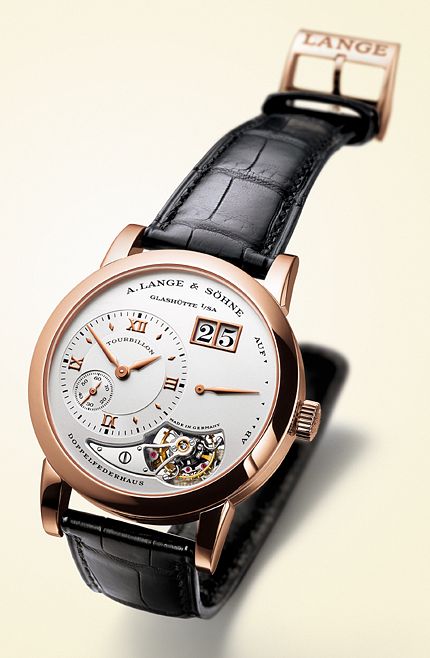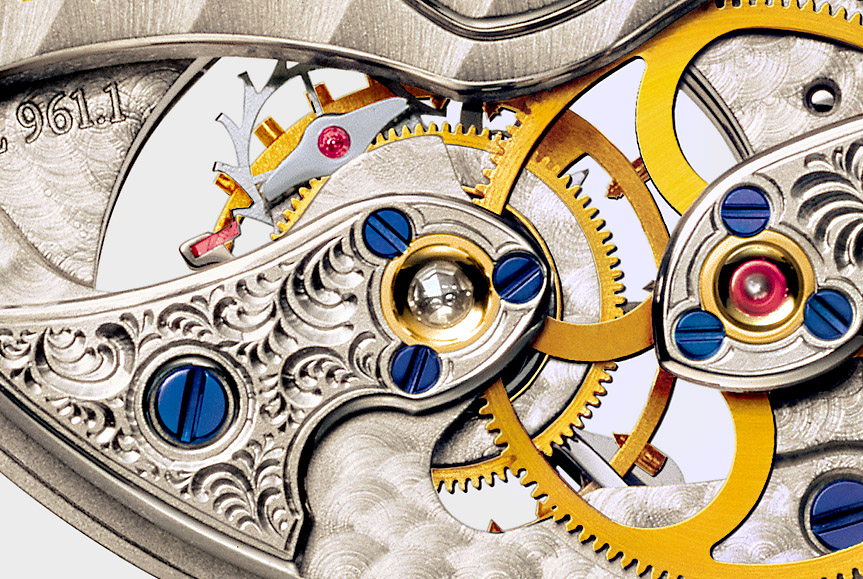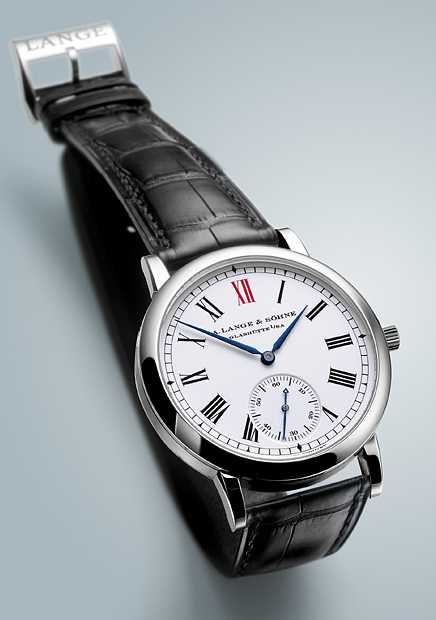Many large pictures...may take a while to load...patience pays...
Basel 2000

In many ways, 2000 was a significant year for Lange. It was the 10th Anniversary of the re-founding by Walter Lange/Gunther Blumlein, it was the turn of the millinium, and in 1999 their parent company, Mannesmann was teken over by the British Telecommunications giant: Vodaphone. The last half of 1999 was a little unsettling for both the folks at Lange Uhren, and wellwishers. Whilst the saga of corporate takeovers continues...as it has forged ahead with the Swatch Group and LVMH swallowing up other small watchmakers (Renaud et Papi by Audemars Piguet, Breguet/Lemania by Swatch are some recent examples), Lange is as of today, still part of Mannesmann. Basel 2000 saw the introduction of an interesting new tourbillon, an enamel dial to celeberate the anniversary, and the long awaited pink gold cases to the rest of the line.
The Lange 1 Tourbillon
So why another tourbillon, after the incredibly successful Pour La Merite? The challange in this tourbillon, seen left which had to fit the dial layout of the Lange 1.
As with all traditional Lange tourbillons, the tourbillon cage rotates in an anticlockwise manner, hence the typical method of mounting the seconds hand on the axel of the cage cannot be done. As the original Lange 1 had an indirect seconds hand at about dial position 4 o'clock, the plan was to put the tourbillon at the exact same location, having the tourbillon cage driven by an intermediate wheel. See below for details.
The result was the introduction of the small seconds hand at about dial position 8 o'clock. This caused a slight gasp in the traditionist Lange camp, ad the original Lange 1 dial was designed in such a way as that no subdial overlays another, and at no time did any hand (except the hour and minute hand) overlay another.
However, looking at the end result shown left, the beauty of the watch radiates, and the visual impact is none the worse for it.
Technical Details
 | Lange 1
The assemblies and jewels supporting the various wheels are labelled.
- k: Keyless works assembly
- B1: Barrel 1. Note the similarity of arrangement of the wheels to that of the Lange 1 Tourbillon till the 3rd wheel.
- B2: Barrel 2
- 2: Second wheel. This wheel makes one revolution per hour, and traditionally it drives the minute hand.
- 3: Third wheel.
- 4: Fourth wheel. This wheel makes one revolution every minute, and it typically carries the direct seconds hand. In the case of the Lange 1, the seconds hand is indirectly driven. The assembly for this is marked in yellow, as "i.s.".
- i.s.: Indirect Seconds assembly. The left-most jewel carries the subsidiary seconds hand in the Lange 1.
|
Lange 1 Tourbillon
- k, B1, B2, and 2 are the same as the regular Lange 1.
- In order to make space for the intermediate wheel (more about this below), the 3rd wheel is moved outwards from the center of the movement. Note this in the diagrams.
- The intermediate wheel "i" drives the tourbillon cage.
In a traditional tourbillon, the third wheel (which turns anticlockwise, as seen from the dial) drives the tourbillon cage, causing the cage to rotate in a clockwise direction (as seen from the dial). However, the Lange 1 tourbillon employs an intermediate wheel (rotating clockwise, as seen from the dial), so that the cage spins in an anticlockwise fashion. This creates the opportunity for some delicate workmanship to be shown on the intermediate wheel. And results in a design which does not allow a seconds hand to be mounted on the axel of the cage.
- As is traditional in a one-minute tourbillon, the fourth wheel, marked "4" is fixed and stationary, allowing the arbour of the fifth wheel (unmarked) which carries the anchor to engage it, resulting in the typical planetary fifth wheel display.
| 
|

Langematic Anniversary

| This year also saw the introduction of the enamel dial for the Langematic. The limited edition watch, in 500 pieces, is available only in platinum, and sports a handmade enamel dial.
Of interest to the collector, is the dial is triple baked: first white enamel is deposited on the dial, and baked in a special oven to create an even, smooth shine. Next, the black roman numerals are hand applied in black enamel, and baked for the second time. Finally, the red "12" marker is applied by hand in red enamel, and the dial is baked for the third time.
The delicate nature of this operation allows for only a small number of dials to be made which are flawless.
Also of interest to collectors, is that although the manufacturing process for enamel dials is delicate, the dials, if one does not drop them and causing the enamel to crack, will typically last longer than a metal dial. Many ancient pocket watches, have survived to this day, with perfect enamel dials. |
The Rose Gold series
To round off Basel 2000, the 1815, 1815 Ab/Auf, and the Langematic will be made available in rose gold case, silver dial, as shown below. These are unlimited editions.

Take me homeI am interested in hearing your comments on A. Lange & Söhne watches, or on this web page. Click here to comment.
I also run a Lange Forum, where anybody can participate and ask questions or share their expreiences.
Finally, if you are a Lange watch owner, either their older watches or those in current production, I am Founding Chairman of the Lange Owners Group. Click here to register yourself.
This page was created by Peter Chong. Last updated April 28, 2000. Copyright © 2000 Peter Chong

FastCounter by LinkExchange



